The Arctic and Alaska
Seabird study finds ecosystem-wide losses in a warming Arctic
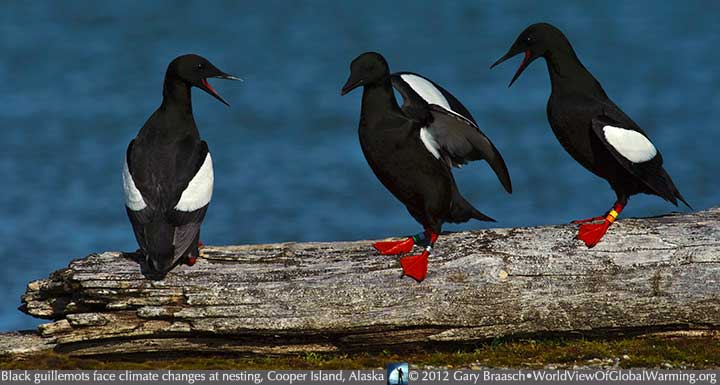
(Note: Click small images to enlarge and diminish.)
A single dedicated scientist’s 40-year study of seabirds in the Arctic is showing how global warming’s dire effects ricochet through entire ecosystems and food chains. “You don’t have to care about Arctic seabirds or pack ice,” says Dr. George Divoky, but the Arctic is not the only place where climate change is causing problems. “Species are struggling to deal with it,” he says, “and we are going to be in the same situation.” In his blog at cooperisland.org, Divoky wrote that “the complete disappearance of the summer sea ice habitat in the Arctic, predicted to occur in this century, will be the largest loss of an ecosystem the planet has experienced in modern times.”
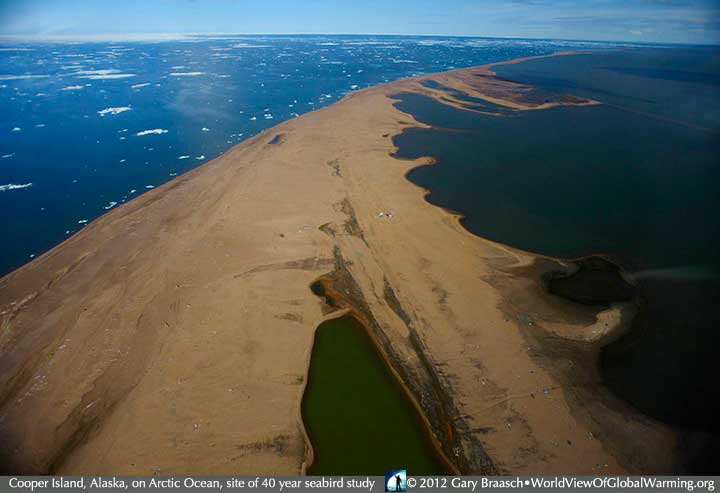
Seabird biologist George Divoky is documenting the increases and declines of a colony of black guillemots on a barrier island just east of Barrow, the northernmost point in Alaska in the Arctic Ocean. Forty years ago in the summer of 1972, Divoky, then with a master’s degree in biology from Michigan State, was part of a biological survey of the Arctic in advance of the establishment of the Prudhoe Bay oil field. His job was to walk the Arctic barrier islands, “like Lewis & Clark,” he says, because no one had ever surveyed them before. Along with the puffins, old squaws, terns, migratory shorebirds and other species, he spotted a few black guillemots apparently breeding in old wooden crates and broken furniture on an otherwise barren sliver of gravel called Cooper Island.
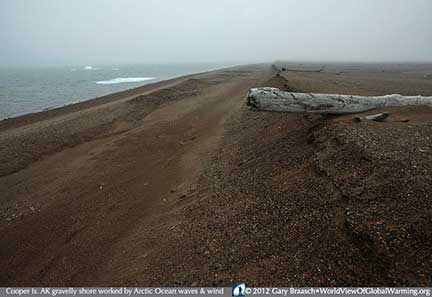
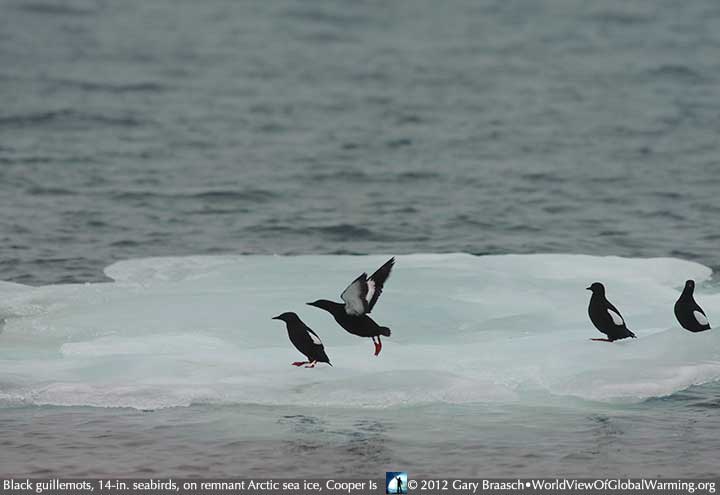
The pigeon-sized guillemots are all-year residents of most of the North American Arctic Ocean, feeding on Arctic cod just under the sea ice, living in crevices in the pack ice, then coming in summer to nest in cliff cavities along the Chukchi Sea coast. Divoky’s research revealed the species did not breed in far northern Alaska until the late 1960s, when warming temperatures allowed nesting for the 80 days needed for successful reproduction. Somehow in 1972, a few breeding pairs of guillemots had been attracted to the dark undersides of debris left behind at a former navy station on Cooper island.
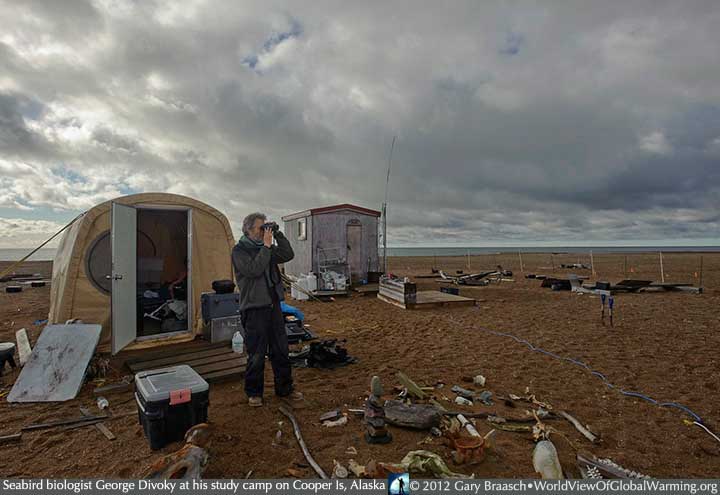
George was intrigued. By 1975 he was back on Cooper Island starting a study which he did not know at the time was going to track not just nesting seabirds but rising temperatures, diminishing sea ice and a shifting ecosystem – and which would find him still living on the island each summer, mostly alone, well into his 60s.
As part of his investigation, George tested the odd nesting behavior of the guillemots by turning over other discarded navy boxes and debris to create more possible nest sites. More birds came in from larger colonies as far away as Russia and settled in to successfully breed, even though summer weather on Cooper Island only lasted about 80 days and sea ice packed up along the shore. From the initial 10 breeding pairs in 1972 and 17 in 1975, soon George was tracking more than a hundred pairs.
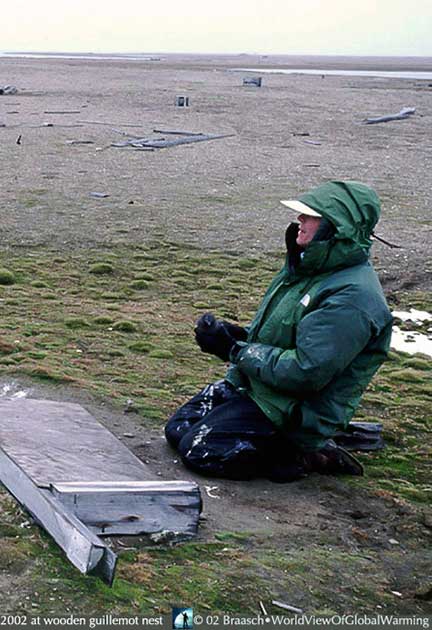
In supporting his independent research, George was not always as successful. His initial funding from BLM and NOAA ended in 1981 and the next year he managed to scrounge up a few hundred dollars, enough just to get back to the island. “It was just me and a tent,” he says. But he had to continue, especially since birds he had banded were beginning to return each summer. George was getting to know these birds like old friends and family members. He has never missed a season, even though he is the rare scientist who does not have a university position and relies on yearly grants and fundraising through his Friends of Cooper Island NGO.
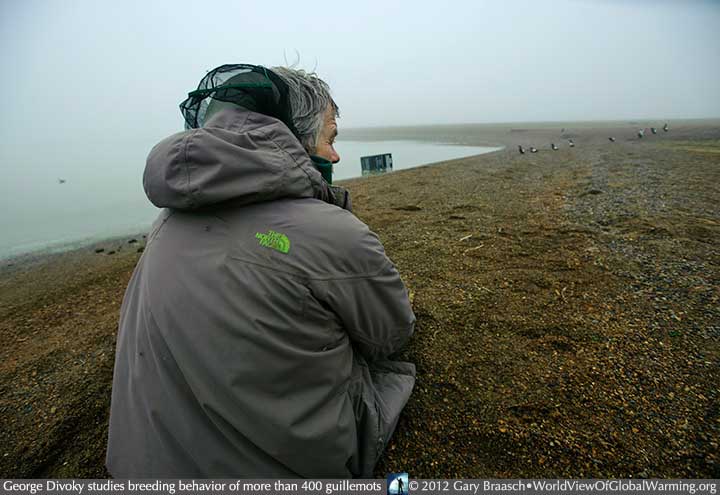
More than 225 pairs were nesting on Cooper by 1989. Observing, weighing and banding the birds was now a 20-hour a day job long into the midnight sun, and George hired on several assistants most summers. Correlating the known factors in nesting success, George was convinced his birds were taking advantage of a climate shift. He realized, he says, that “even finding the colony here was a climate change signal.” By the 1990s, summers were warming significantly and the time available for the guillemots to feed and fledge young had lengthened to more than three months. And there was a slow retreat of Arctic sea ice from around the island, creating an nearby area of open water and ice pack edge making it easy for birds to fly out at 25 mph, dive the few feet under the ice to grab Arctic cod and return to feed the young, sometimes at a rate of a fish per hour, around the clock. Guillemot adults were successfully fledging two healthy chicks per nest.
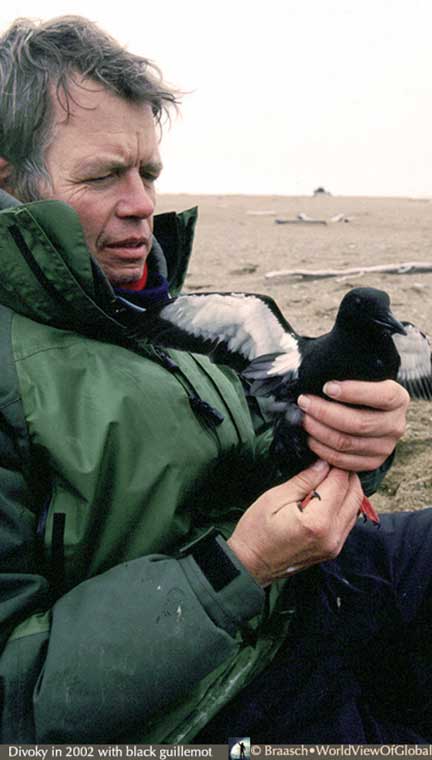
Relentlessly at the end of the 1990s and into this century, however, Arctic warming continued. Late summer ice pulled out farther from the island, taking with it the prime prey of the guillemots, the cod. With the ice sometimes 100 miles out, the birds had to turn to alternate but less nutritious food like skulpin. George has found that the arctic cod disappear from the feeding area not only when the ice is gone but also if water temperature rises above 4 degrees C – a very common situation now. Temperature and depth sensors he has attached to a few birds show that under those conditions the guillemots must fly much farther to find cod under ice and if they do not, they have to dive down to the bottom as deep as 28 m (90 feet) trying to catch sculpin or other bottom fish. This is a huge energy outlay for the adults and yields prey that is much less nutritious than the cod. The warmth and longer summers also allowed horned puffins, a sub-arctic bird, to fly in from the mainland in the south, and nest competition increased. Many guillemot chicks starved or were killed in nest disputes with the invading puffins. The black guillemot colony declined to fewer than 150 active nests and chick fledging rates per nest kept going down.
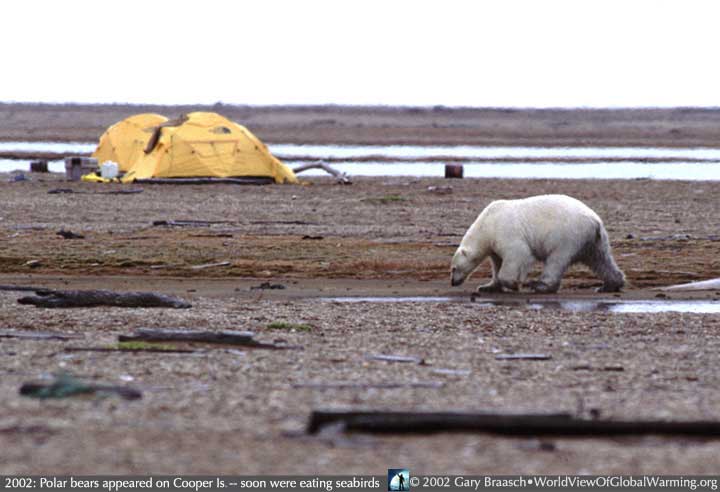
Then in August 2002 the shifting ice and climate brought another invader. Working in the low midsummer sun and light fog to check nests down some distance from their camp, Divoky and an assistant suddenly had a clear view of a polar bear and two cubs wandering down from the east end of the island. Soon there was another bear, closer, much closer, which strolled right through the camp of three tents. George’s second assistant was standing on the other side of camp as the bear ambled on past the tents toward the shore. It appeared the animals were caught on land by open water and were just following the shore to find pack ice. These were the first polar bears he’d seen directly on Cooper, and George was immediately concerned about the safety of his assistants and that he did not have any defense: “The only gun is in that tent!” he remembers thinking. When the bear passed, he immediately rushed to grab the gun (he has not walked out on the island without his shotgun ever since).
Photojournalist Gary Braasch who happened to be visiting the camp that day made photographs of the bears on the dry gravel island instead of on the ice where they belong, which have become strong images of the effects of climate change in the North.
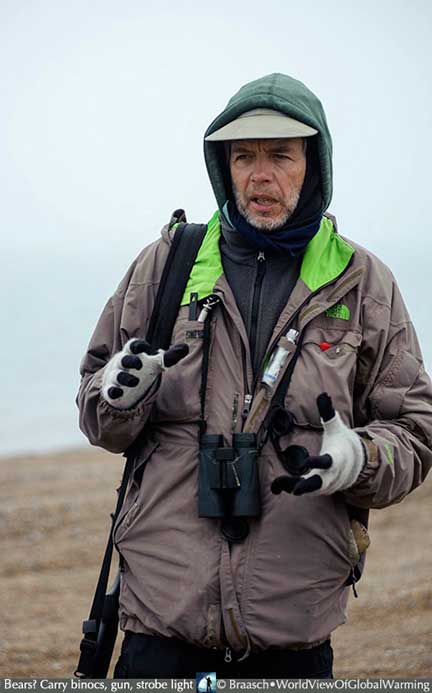
With concerns for Braasch and his assistants, George called in a search and rescue helicopter from Barrow to scare the bears off. Evacuation by chopper was not necessary, but as the summer continued, bears appeared again and Divoky had to stop his work on Cooper Island a little early to be safe.
Since that first appearance in 2002, George has had more than 50 bear encounters, including one bear that tried to get in the door of his shelter and ended up sleeping right outside, trapping George indoors. He has steadily increased his security with a permanent sleeping and working hut, bear alert tripwires and the current electric fence around the camp. Gunfire definitely scares the bears, but George does not like to shoot. “I haven’t fired a gun for a bear in three years,” he said, “it’s all lights and noise now” if a bear approaches too close. George found that a focused strobelight is apparently very unpleasant for a polar bear and insists that visitors carry one whenever they walk the island.
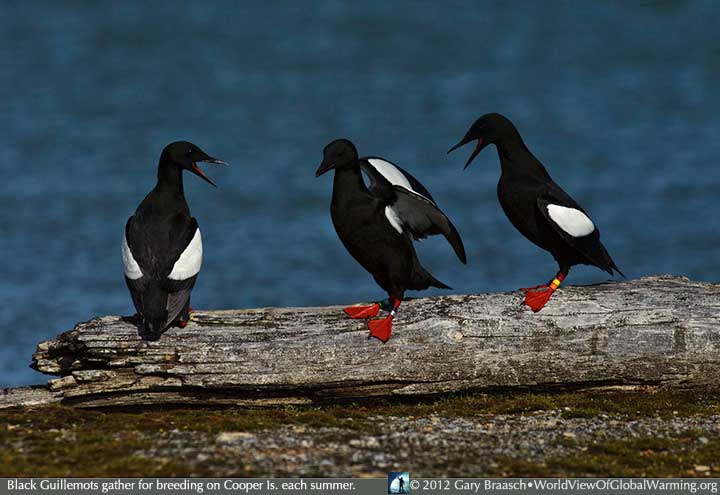
In the early 2000s his study reflected more and more how the black guillemots were unable to feed chicks effectively with sea ice many miles away from the island and with competition from the invading horned puffins due to warmer temperatures. By 2003 he was able to see that in most nests one chick was thriving but a lack of food doomed the second one. George’s careful data reflect that “in 2006 ice was close to shore and arctic cod made up almost all the guillemots’ diet. Then in 2007, the ice retreated and arctic cod in the diet declined to just 20 percent.” In 2007 the arctic sea ice cover reached its lowest since satellite measurements began in 1979 (it reached an even lower extent in 2012). The rise and fall of the colony since 1972, tracked by chick survival, growth rates and fledging weight, was a clear result of climate changes.
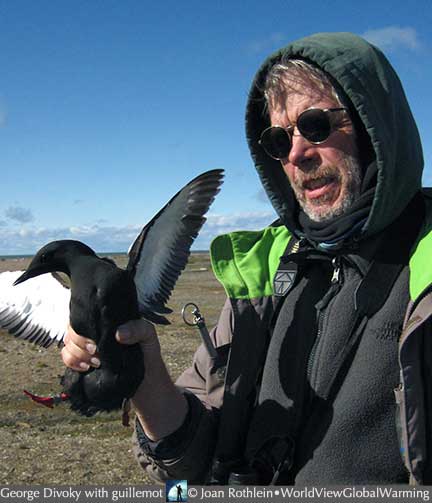
For George, the late summer appearance of wandering bears might have been a separate observation of change. Unfortunately for both guillemots and puffins, many bears, unable to get out on the ice and being very hungry, learned that there were small but tasty morsels to eat under some of the wooden debris. By 2007 nest success was falling rapidly, with chick deaths equally caused by bear predation, puffin competition and sea ice distance. Disaster struck in 2009 –183 guillemot chicks hatched, of which 81 were killed by horned puffins and nearly all the rest were eaten by bears. Only one guillemot fledged.
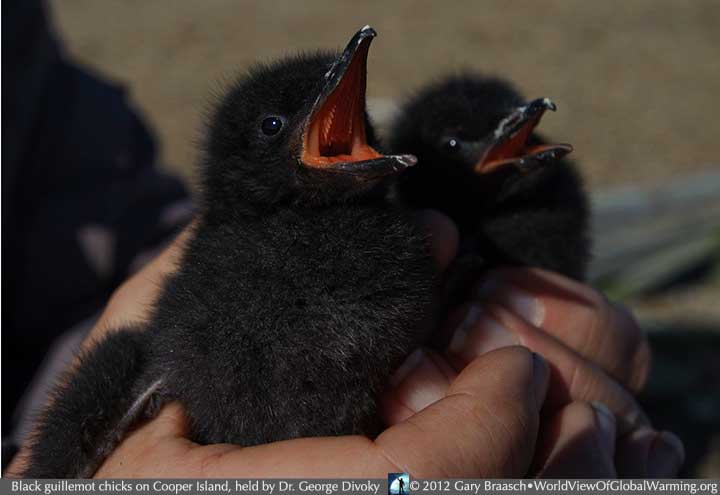
George was understandably devastated. “It was very bleak,” he remembers. “I had pockets full of dead chicks.” And the situation continued with very few fledglings in the next year as well. He had 35 years of continuous study and a robust correlation between Arctic climate change, sea ice loss and the nesting success of the guillemots. Much more personally, as he opens a nest, discovers and handles a new chick, lovingly measuring and weighing it, it is clear that he really loves these birds, they are like his family. He is totally involved with the birds’ life history, watching adult pairs return year after year to the same nest, seeing chicks he banded fledge and then return 3 to 4 years later as adults. Some of these guillemots are now more than 30 years old.
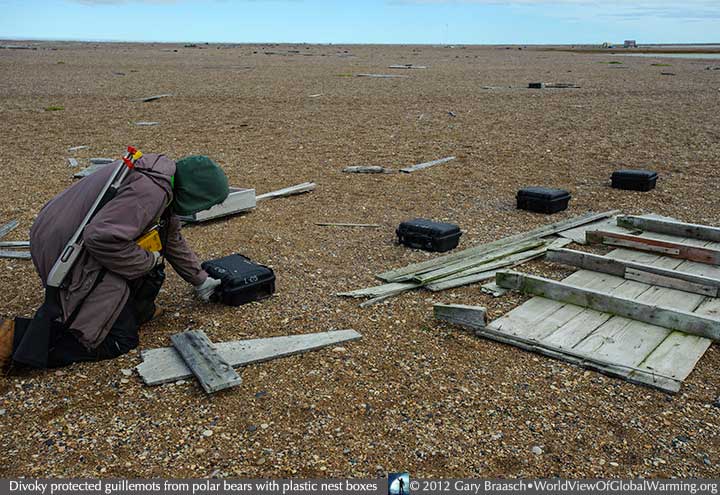
He faced a rather unique question for a scientist trained in careful observations: Should he let the invasion of bears and puffins run its course as the outcome of the warming climate on Cooper Island, which would probably end the colony. Or should he protect the birds --was the correlation between the guillemots and the sea ice over almost 40 years the most important data, the real key to tracking how the loss of the ice was affecting an entire ecosystem. That was the most important, he decided, as he told a scientific meeting in 2011, “this is the only colony up there monitoring change in the Arctic, and it’s the only colony that has 40 years of data prior to this major melt. There are also concerns about off-shore drilling, commercial fishing, and other things there…”
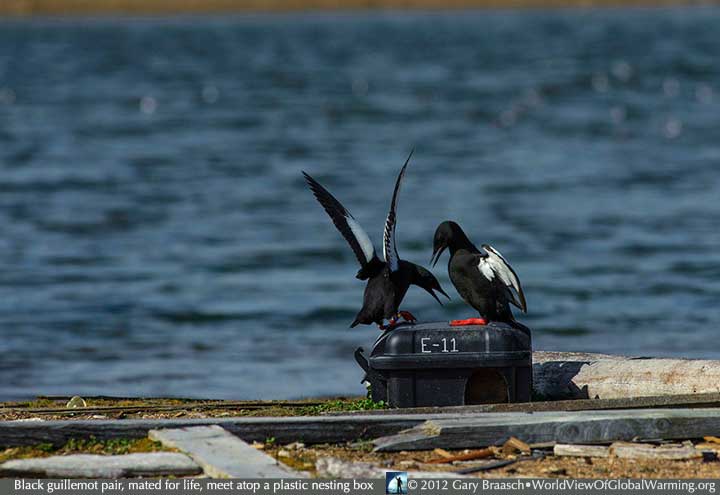
So he set out to save the colony from the bears and discourage the puffins. He adapted heavy waterproof plastic cases, made to protect photo and electronic gear, with holes drilled on the side and a baffle inside to give the guillemots a dark and safe nest. Before the 2011 nesting season on Cooper, he turned over each active wooden nest site and placed a new nest box in the same location. When the birds began flying in, most took right to the new nests. By 2012 he’d converted all the 200 nest sites to the hard plastic boxes.
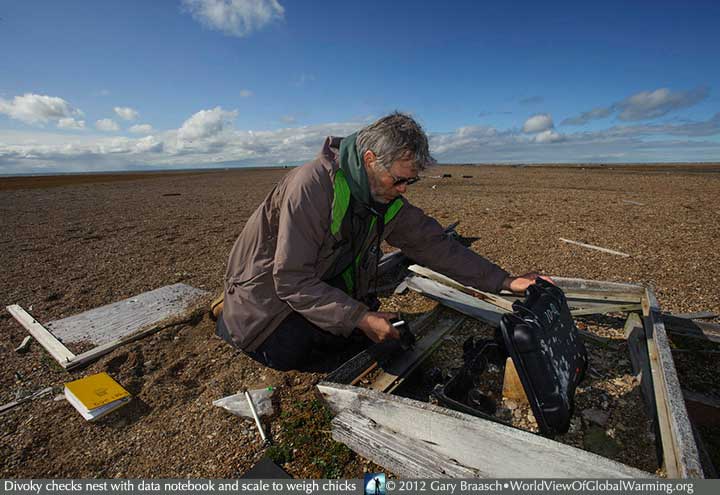
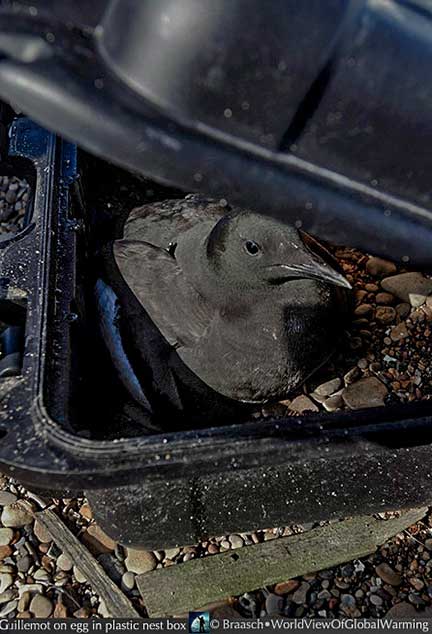
Guillemots easily enter and lay eggs in the boxes. Polar bears were unable to get into them or break them by bouncing on them – looking something like the gorilla in that luggage commercial of a few years ago. The box entrances are just a bit small for the larger puffins. The colony’s fledging success rebounded from only 10 chicks in 2010 to 110 in 2011 and even more in preliminary data from 2012. The study can continue monitoring how the shrinking of Arctic sea ice will affect the per-nest rate of chick survival. The black guillemots are very sensitive monitors of ocean habitat because of the food they forage for the chicks, and the information George is getting from tiny temperature, water depth, and geo-position sensors attached to some of the birds.
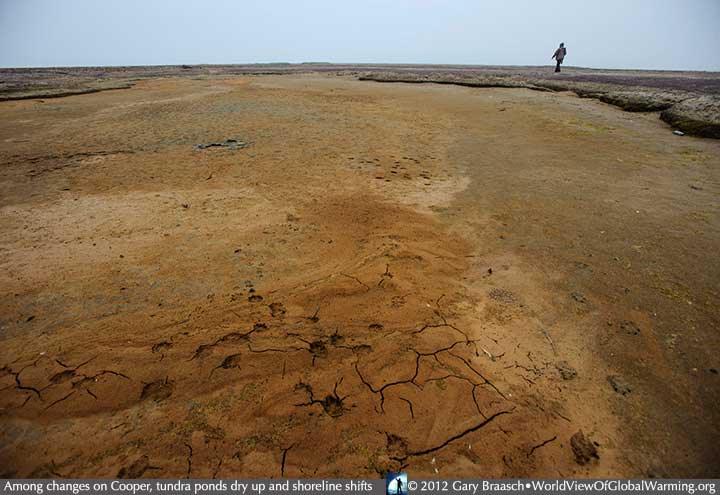
Now on Cooper island, summer season is a full month longer than when George began his studies. Even though he has seen little sea level rise effect, the island is changing, with shifting shorelines, thawing permafrost and once crystal freshwater ponds turning brackish and drying up. And the sea ice continues to recede to its lowest extent ever measured. At the end of the 2011 season, when the young guillemots had all fledged, the birds had to fly more than 300 miles north over open water to find the ice pack on which they would live over the winter.
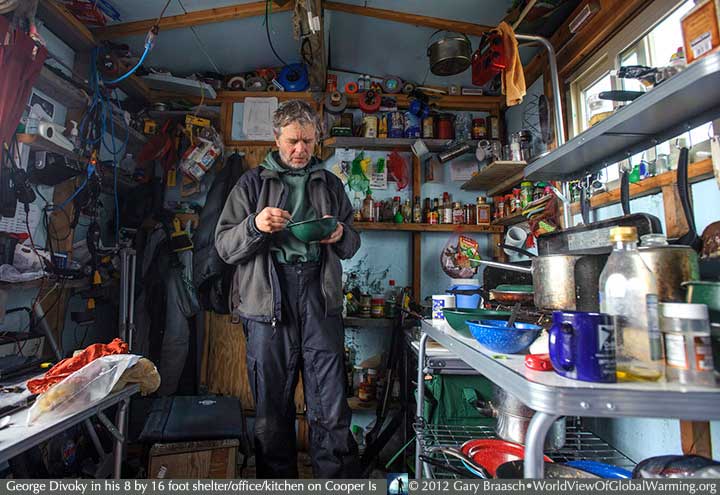
The study which George began more than 40 years ago on his solitary walk along Cooper Island continues. He returns every summer, still mostly alone, to live in his well-stocked hut. But it is uncertain how long it will be before the Arctic sea ice is too far gone even early in the nesting season for guillemot chicks to survive. Increasingly he realizes how much of the entire Arctic Ocean ecosystem is stressed as the ice diminishes -- the plankton, the cod, the whales, the sea birds and mammals, including the native humans of the North -- and how important is his guillemot's eye view.
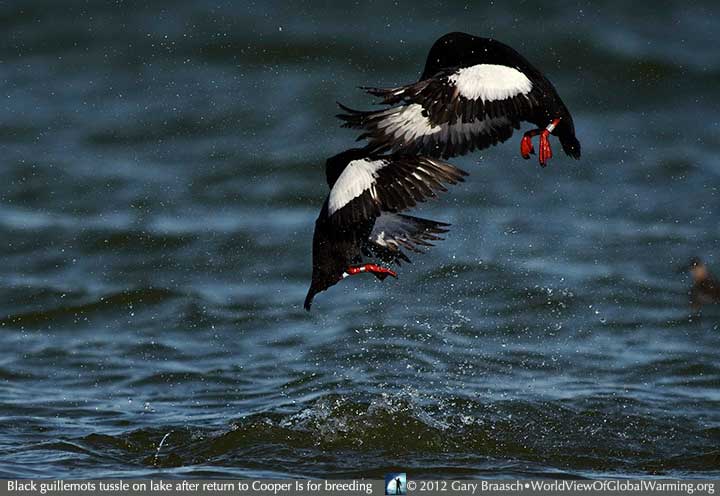
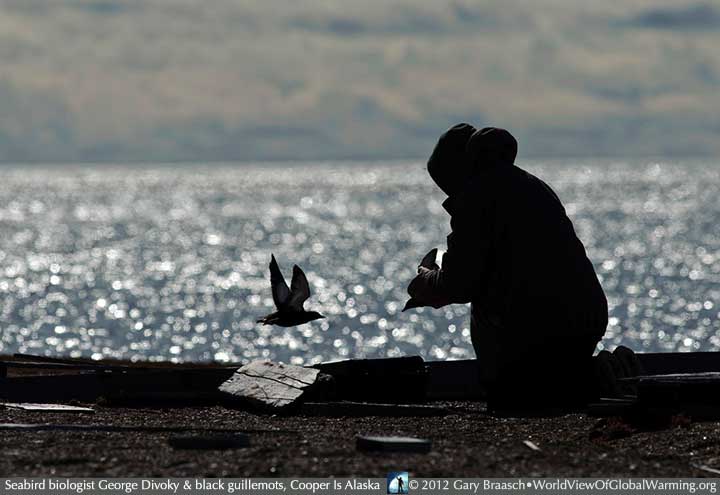
There is no other such long-term research along the Alaska coast. “With Shell [Oil] doing what they are doing, it’s important to keep this thing going,” he said. “It’s important to do this, doing what nobody else is doing." He is laying down a baseline of observations as the sea ice disappears and oil spills are possible, and showing the effects of warming resulting in what he calls the “unprecedented biological loss and degradation of a unique marine ecosystem.”
For more about Dr. George Divoky, including videos, please see here and here.
http://www.nytimes.com/2002/01/06/magazine/george-divoky-s-planet.html?pagewanted=all&src=pm
Photographs from the World View of Global Warming are available for license to publications needing science photography, environmental groups and agencies, and other uses. Stock photography and assignments available.
Use of photographs in any manner, in part or whole, without permission is prohibited by US copyright law. These photographs are registered with the US Copyright Office and are not in the Public Domain.
COPYRIGHT NOTICE:
Photography and text Copyright © 2005 - 2017 (and before) Gary Braasch All rights reserved. Use of photographs in any manner without permission is prohibited by US copyright law. Photography is available for license to publications and other uses. Please contact requestinformation@worldviewofglobalwarming.org. View more of Gary Braasch's photography here.


